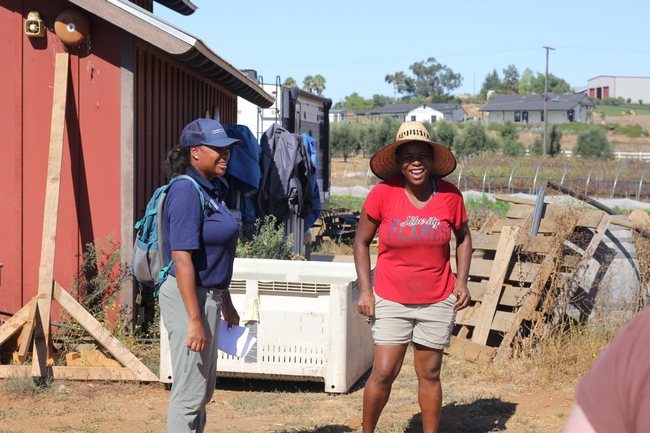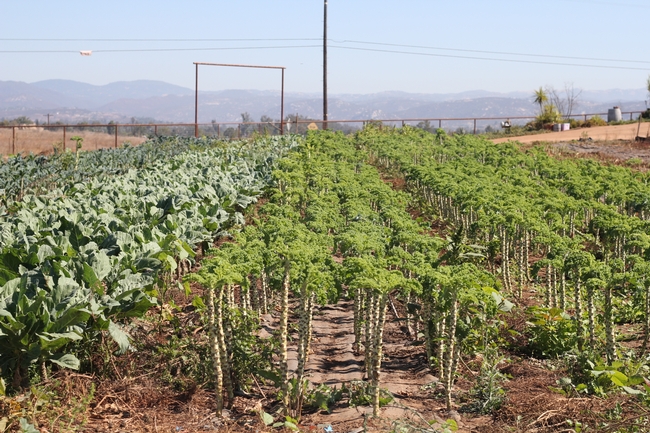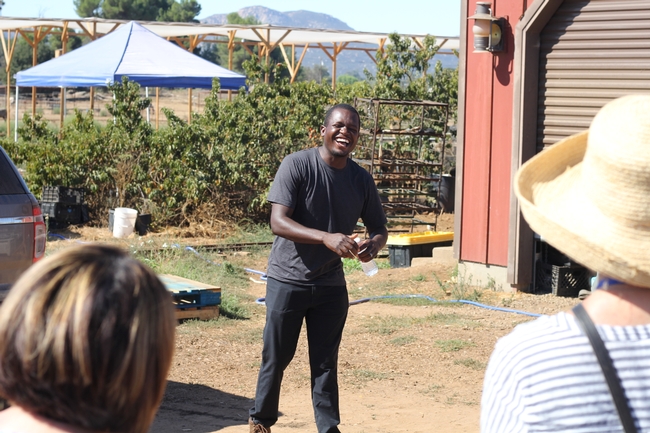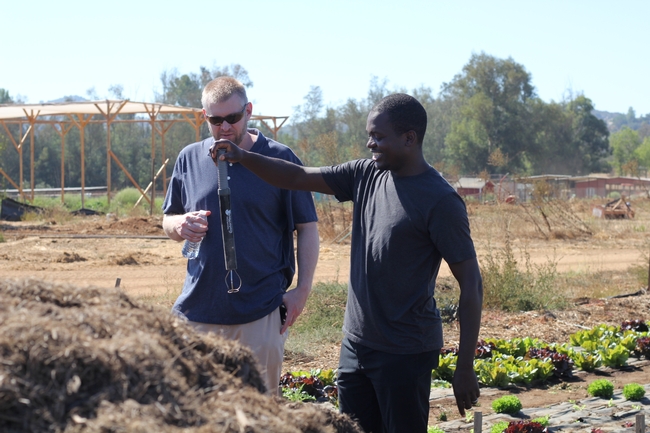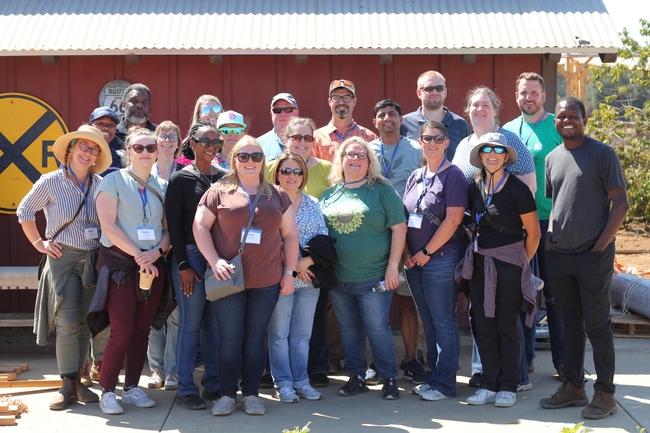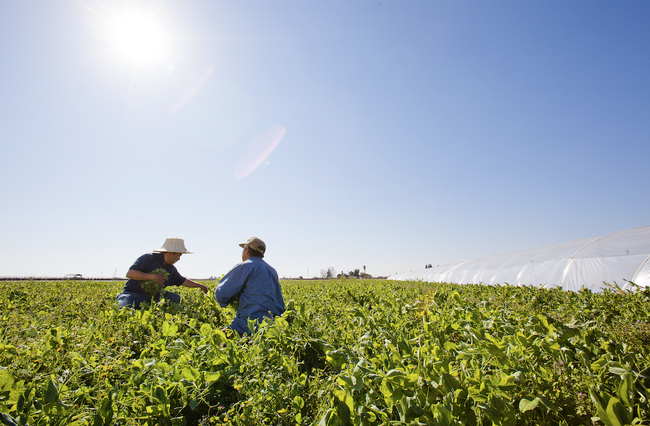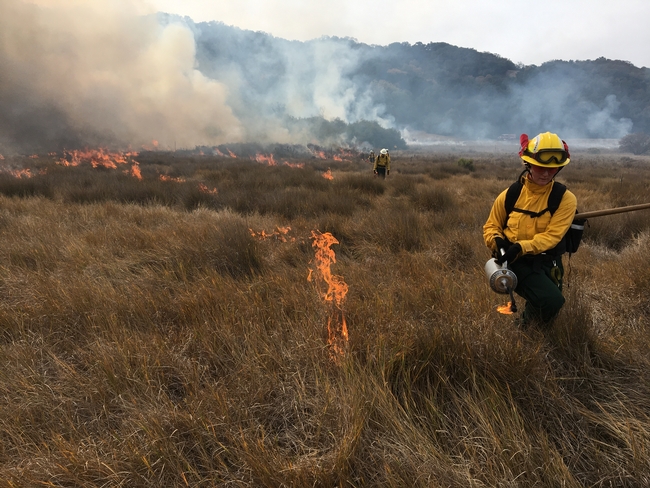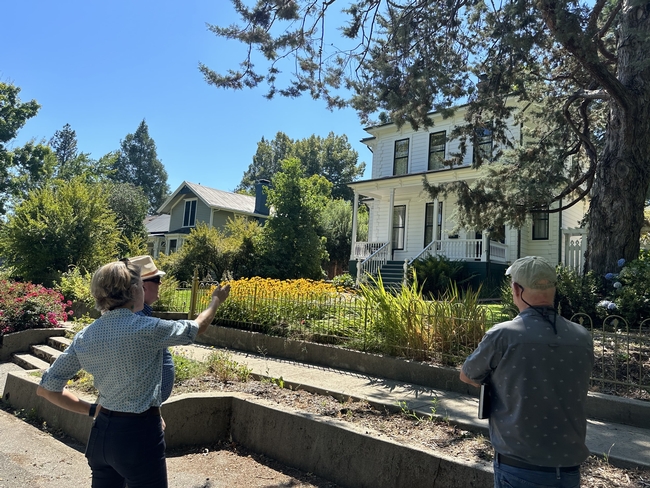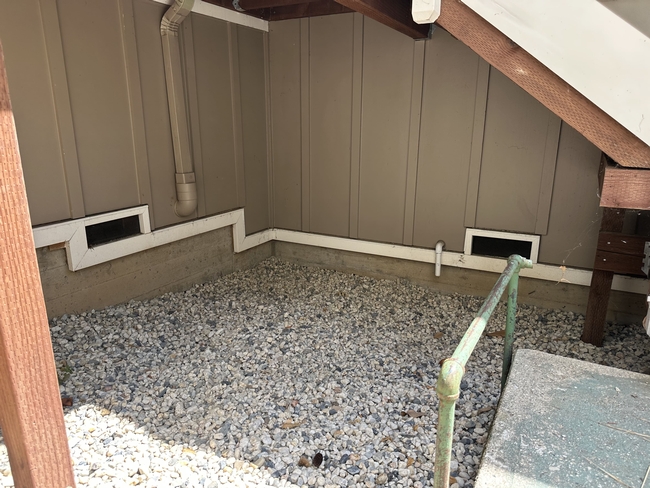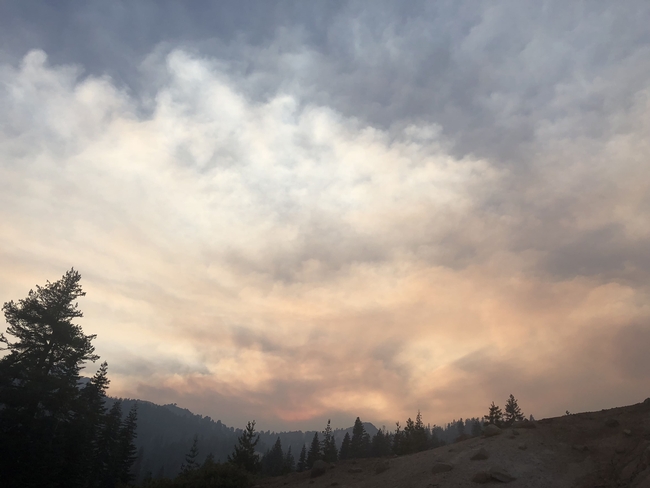Posts Tagged: environment
UC ANR project to help underserved farmers in SoCal with land ownership
San Diego County has more than 5,000 small farms but less than 2% are operated or owned by Black, indigenous, or people of color – including those of Asian, Hispanic or Native Hawaiian/Pacific Islander descent, according to the 2022 Ag Census.
The reasons vary, but historically, multiple marginalized communities of color have not received the same opportunities or support for land ownership or management as their white counterparts.
Chandra Richards, University of California Cooperative Extension land equity academic coordinator for the Southern California region, is identifying barriers to equity when it comes to addressing land access, tenure, management and opportunities to increase the diversity of land managers and land ownership in the region.
Richards is the principal investigator for the Climate Action and Land Equity (CALE) project administered through UC Agriculture and Natural Resources and funded by the Department of Conservation. CALE aims to engage historically underrepresented communities in coalition building, capacity assessment and climate action planning. CALE elevates knowledge about the challenges and opportunities to land access and management for a diversity of land managers.
Among the challenges is land tenure, an established agreement between a landowner and tenant, outlining the purpose and use of the land over a period of time. However, when landowners decide to sell their land, these agreements are at risk of being null and void, forcing the tenants to renegotiate or discontinue their operation.
Land tenure leases for under five years are considered short-term, which are common in Southern California. For small, new and under-resourced farmers, landowner turnover doesn't just threaten their business plan but their livelihood.
For small farmer Byron Nkhoma, who leases land in Ramona to grow leafy greens and vegetables, the possibility of losing land is a constant worry. Since 2015, Nkhoma and his wife, Joyce, have been renting four of 20 acres to establish Hukama Produce. Over nine years, they have had two landowners. Before the land was sold to his current landowner, Nkhoma said he considered buying land, but the process proved more challenging than he thought.
“What it takes for someone like Byron to find a place to farm and establish a food system is an extremely involved process,” said Richards. “It's not just learning how to obtain land, it's also about managing that land so it can be used for years and generations to come.”
Originally from Zimbabwe, Nkhoma is adamant about taking care of the land he leases and has applied knowledge from his home to ensure resilience. Hukama Produce prides itself in improving environmental health through sustainable farming practices such as compost and mulch application, drip irrigation and low till. An important pillar of the CALE project includes building capacity and providing technical assistance toward land conservation and climate resiliency.
In addition to land tenure, money and time are stressors for small farmers. When they are not working on the farm, Nkhoma and his wife are researching and applying for grants to improve their soils and protect their crops from pests. However, many grants for which Hukama Produce is eligible often have pressing deadlines that demand their immediate attention – cutting into valuable time that could be spent tending to the land or selling at farmer's markets.
Two of Hukama's goals include building and sustaining trust in the market and growing their operation. By partnering with Richards, Hukama Produce has direct access to technical assistance focused on grant writing and conservation to increase ecosystem health and build tenure.
Agricultural land tenure is the arrangement, rights, and responsibilities centered around use, management, and ownership of agricultural land and resources. Building land tenure means that farmers have a stable place to grow their crops and build environmental sustainability without risk of having to move their operations.
While the CALE project boosts support for historically underserved community members hoping to own or manage land, it prioritizes land use for food production as a reinvestment into the greater community.
Eager to bring realities like Nhkoma's to light, Richards partnered with Keith Nathaniel, UCCE director for Los Angeles County, who co-coordinated the Western Extension Leadership Development conference held in San Diego the week of Sept. 23-27. WELD unites Cooperative Extension faculty, agents, advisors, educators and specialists from the western region of the United States for a two-year leadership development program.
While in San Diego, WELD participants joined Richards for a tour of Hukama Produce and learned directly from Nkhoma about opportunities and threats as a small farmer. The tour ended with participants in a circle, sharing how their professional roles can offer support to Hukama Produce and other small farms.
“We grow food so that we can feed the community,” said Nkhoma. “When we feed others, we build relationships. That's what ‘hukama' means – to grow relationships.”
If you operate or know of a small farm in Southern California and would like to be involved with or receive regular updates about the CALE project, please contact Chandra Richards at cmrichards@ucanr.edu.
If you are interested in applying for the Land Equity Project Manager position, please visit https://ucanr.edu/About/Jobs/?jobnum=2894 for details.
White House Summit explores impact of extreme heat, ways to adapt
UC ANR Small Farms Network supports small-scale and underserved farmers impacted by extreme heat
Ruth Dahlquist-Willard, interim director for the UC Sustainable Agriculture Research and Education Program, joined more than 100 participants from across the country at the first-ever White House Summit on Extreme Heat. Community representatives and practitioners met with federal agency representatives and Biden Administration officials to discuss successful locally tailored, community-driven practices to adapt to extreme heat as well as available federal resources.
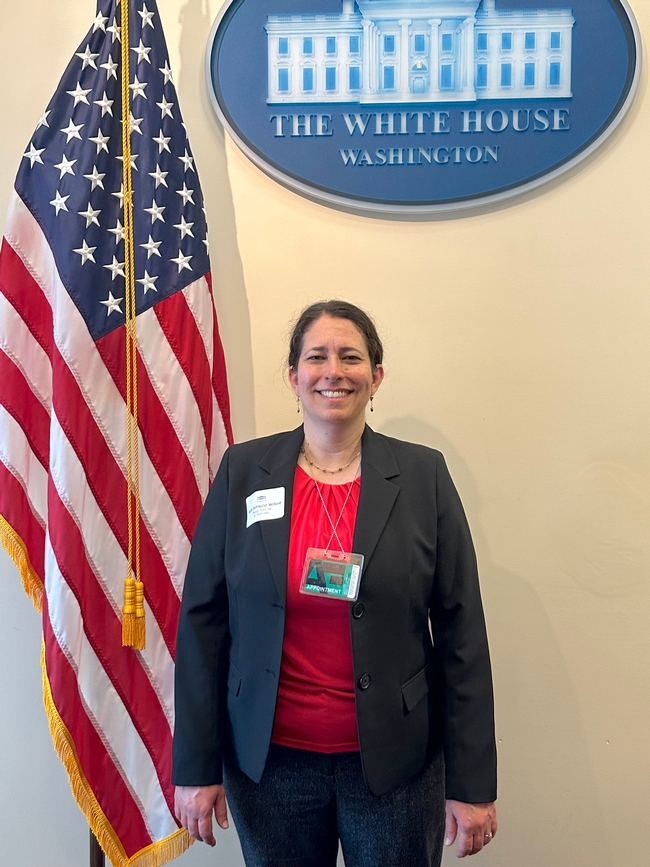
In the agricultural sector, extreme heat events can cause heat illness in farmworkers, crop losses and changes in pest pressure. California crop losses due to drought, wildfire and heat were estimated at $239 million in 2023.
Disaster relief funds are available to help growers recover from lost production due to extreme heat. Since 2021, the UC ANR Small Farms Network has connected small-scale farmers with over $5.8 million in direct-to-producer relief funds for losses related to drought, flooding and other extreme weather events.
To further support small-scale farmers in adapting to the changing climate, Dahlquist-Willard and the Small Farms Network are evaluating how the extreme heat of summer 2024 impacted farmers. Farmers reported anecdotal observations that included:
- Shifting work hours to cooler parts of the day
- Closing farm stands and farmers markets due to extreme heat
- Crops ripening more quickly than expected, impacting harvesting and packing schedules
- Poor fruit set due to extremely high temperatures
The team is working to determine what damage symptoms on small-acreage California specialty crops can be attributed to extreme heat based on scientific literature and assessments from UC ANR colleagues. Understanding the impact of extreme heat on the farming community can help inform research and policy, ultimately equipping farmers with strategies to adapt to extreme heat events.
“It was inspiring to meet with leaders from around the nation who are working to support communities impacted by extreme heat and learn about the creative solutions they are implementing,” said Dahlquist-Willard. “The challenges faced by these communities make it all the more important to continue to work against climate change by reducing greenhouse gas emissions, as well as to develop new methods and resources to mitigate the effects of extreme heat and other climate impacts.”
The Extreme Heat Summit highlighted the Biden-Harris Administration's investments in climate reliance and put forth an Extreme Heat Call to Action calling upon public and private sectors to prepare for future extreme heat events. Communities and governments interested in participating are asked to use all available tools to protect people from extreme heat. Approaches and tools which could be used to protect people and resources from extreme heat are highlighted in the U.S. Climate Resilience Toolkit and the National Heat Strategy. Submissions for the Call to Action will be accepted through Nov. 1, 2024.
Further reading:
Heat Illness Prevention, UC Davis Western Center for Agricultural Health and Safety
Pathak et al., 2018. Climate Change Trends and Impacts on California Agriculture: A Detailed Review
UC's New Climate Action Goals: Frequently Asked Questions
Hands-on learning, training make irrigation best practices accessible
UCCE advisors provide free training to nursery and greenhouse staff
Working as an irrigator seems straightforward at first: if you're not watering plants by hand, you're building and managing systems that can do the watering. What could be complex about a job like this?
University of California Cooperative Extension advisors Bruno Pitton and Gerardo “Gerry” Spinelli can tell you – or better yet, show you.
Pitton and Spinelli, members of the UC Nursery and Floriculture Alliance, offer a one-day technical training in irrigation best-management practices for irrigators working with containerized nursery plants. The comprehensive curriculum – developed with input from two focus groups of California nursery and greenhouse managers – aims to improve irrigation efficiency, reduce water consumption and improve plant health.
Thanks to funding from the California Department of Food and Agriculture, nursery and greenhouse managers in California can request this training for free and advisors like Pitton and Spinelli will travel to conduct the training on-site.
The complexities of irrigation incorporate concepts like evapotranspiration, salinity, irrigation uniformity, capillarity, pressure and flow rate. Spinelli, UCCE production horticulture advisor for San Diego County, said that irrigators have a critical role in the industry because of all the things they must consider to do their job well.
“Our goal is to support irrigators and help them become more confident decision-makers and experts in the field,” said Pitton, UCCE environmental horticulture advisor for Placer and Nevada counties.
Interactive sessions reveal nuances of irrigation
The training consists of a presentation on fundamental concepts for managing irrigation in container plant production and hands-on demonstrations. “In the nursery industry, where precise irrigation is crucial for the health and productivity of our crops, having access to expert knowledge is invaluable,” said Mauricio de Almeida, general manager of Burchell Nursery in Fresno County. “The training's practical demonstrations and real-world examples made the concepts easy to grasp, allowing our team to implement the strategies immediately.”
For one of the demonstrations, the advisors used sponges to model soil saturation when water is applied. Ana, an irrigator at Burchell Nursery, appreciated the step-by-step explanations, which helped her better understand how water pressure differs in drip irrigation, sprinklers and watering by hand. Doing this out in the field, as an example of how irrigation audits occur, was extremely helpful for attendees.
Francisco “Frank” Anguiano, production manager of Boething Treeland Farms in Ventura County, observed his team of irrigators as they learned how to measure distribution uniformity with water collected from sprinklers. “This training isn't just about irrigation and plant management. It's also about savings, both water and costs. Who doesn't want to save money and use less water?” Anguiano said.
Reducing the barriers to learning
Many of the irrigators attending these trainings gained their skills and knowledge from life experience rather than a college education, explained Peter van Horenbeeck, vice president of Boething Treeland Farms. “It's important that my irrigators learn from external experts, but it's more important that they can relate to them. And that's what Gerry was able to do,” van Horenbeeck added.
Regarding content and delivery, and referencing what he learned from the focus groups, Pitton wanted the trainings to be easy to understand and engaging. For example, scientists use the term “matric potential” to describe how soil particles hold water against gravity, which is the same as capillary rise. “We demonstrate this concept with a paper towel held vertically and dipped into a beaker of dyed water that it absorbs,” said Pitton.
Many of the irrigators in attendance agreed that hands-on activities and visual aids were instrumental to their learning. Charli, another irrigator at Burchell Nursery, shared that the in-field examples and hosting the training in Spanish kept them engaged.To address language barriers, Spinelli has been conducting trainings in Spanish – a common request from many nurseries with eager participants.
Maintaining state regulations and partnerships
Although the technical aspects of irrigation management are key elements of the training, regulatory compliance is also addressed. Recognizing the finite availability of water and the environmental impact of pollution, the advisors highlight irrigation and fertilizer management and runoff prevention as critical components of compliance.
Under Ag Order 4.0 administered by California's Water Resources Control Board, growers must comply with stricter policies regulating nitrogen use. As irrigators learn from the training, better control of irrigation can certainly make a difference.
Deanna van Klaveren, chief operating officer and co-owner of Generation Growers in Stanislaus County, said the most valuable aspect of the training was learning on-site and completing an audit on her own systems. “It is so much more impactful to have trainings like this on-site where our staff can learn and then go out into the nursery and actually put it into practice while the presenters/experts are there,” van Klaveren said.
Pitton and Spinelli described the partnership between UC Cooperative Extension and CDFA as “symbiotic” given the technical and educational capacity of UCCE advisors who conduct research and extension.
“It's a great example of how the two institutions can collaborate successfully. Californians are the ones who win because they get a service for free,” added Spinelli. “And it's rewarding for us to see so much interest in what we, as advisors, do.”
If you are a nursery or greenhouse operator and would like to request the Irrigation Best Management Practices training, please contact the UCCE advisor assigned to the region that corresponds with your nursery location below.
Northern California
- Jessie Godfrey, UCCE environmental horticulture and water resources management advisor, jmgodfrey@ucanr.edu
Central Coast (Santa Cruz County to Ventura County)
- Emma Volk, UCCE production horticulture advisor, evolk@ucanr.edu
San Joaquin Valley
- Chris Shogren, UCCE environmental horticulture advisor, cjshogren@ucanr.edu
Southern California
- Grant Johnson, UCCE urban agriculture technology advisor, gejohnson@ucanr.edu
Spanish Trainings Only
- Gerry Spinelli, UCCE production horticulture advisor, gspinelli@ucanr.edu
Public invited to see ‘good fire’ Oct. 5 at Central Coast fair
Learn the how, where and why fire is used to manage the natural landscape at the Central Coast Good Fire Fair on Saturday, Oct. 5. The fair is free and open to the public from 10 a.m. to 3 p.m. at Henry Cowell Redwoods State Park in Felton in Santa Cruz County. The event is sponsored by the UC Agriculture and Natural Resources Fire Network and California State Parks.
“You can witness a live prescribed fire in the redwood grove and learn about using fire in our coastal ecosystems,” said Barb Satink Wolfson, UC Cooperative Extension fire advisor for San Benito, Santa Clara, Monterey and Santa Cruz counties.
Representatives of California State Parks, CALFIRE, indigenous groups and the Central Coast Prescribed Burn Association are scheduled to talk about how they work with fire.
The Good Fire Fair will offer educational activities for children and adults:
- Learn how to safely build, tend and extinguish a campfire
- Watch live burns of piles and redwood understory growth (likely between 11 a.m. and 1 p.m., depending on the weather)
- Savor sandwiches, burgers and Venezuelan food from local food trucks
- Observe demonstrations and visit informative booths
- Learn how to make your home more resilient to wildfire
- Test your fire knowledge and win prizes
“Kids will get to see a wildland fire engine up close, try fire science experiments and play educational games. Bring a camera,” said Satink Wolfson. “Knowledge feeds the soul, but two of Santa Cruz's best food trucks will feed your hunger!”
The event is free, but parking at the park is $10. No registration required.
Simple tasks make big difference in preparing for wildfire, smoke
UC ANR Fire Network compiles expert advice on preparedness, evacuation tasks
The explosive growth of the Park Fire in Northern California was fueled by recent, intense heat waves and extremely dry vegetation – conditions seen at many locations across the state.
Given the potential for wildfire and smoke impacts during what is expected to be a protracted “fire season,” California residents should think ahead and complete emergency preparations: https://ucanr.edu/sites/fire/Preparedness/.
“If you are concerned that you or someone you know could be affected by fire or smoke, now is the time to take simple steps to prepare,” said Yana Valachovic, University of California Cooperative Extension forest advisor for Humboldt and Del Norte counties.
Valachovic and other members of the UC Agriculture and Natural Resources Fire Network are urging community members to tackle small but significant tasks to minimize potential fire damage. Many of these tasks can be finished in a weekend, such as:
- Clean debris from your roof and gutters.
- Inspect the area around your home and nearby structures and remove all combustibles (dead grass, plants, woody mulch, stored wood, etc.) in the first 5 feet, including under decks and stairs.
- Inspect the foundation, under-eave, and gable-end vents for holes and damage; add a layer of finer metal-mesh screens (1/8” mesh) to the vents to prevent ember penetration.
- Inspect the garage door bottom seal to make sure embers can't blow under the door.
- Replace the first 5 feet of wooden fences that attach to buildings with a noncombustible panel or gate.
A recently published report, “Retrofitting a Home for Wildfire Resistance,” also can help residents prioritize the measures that are most cost-effective and fit their budget.
Six things to do, six hours before evacuation
As evacuation warnings are issued for local communities, there are six important things to do in advance of an actual evacuation order, according to Valachovic:
- Close windows, pet doors and skylights.
- Move inside patio cushions, brooms and door mats; tie open wooden gates that attach to the house or deck to prevent a fire from traveling from the fence to the house.
- Relocate the barbecue propane tank away from home.
- Stage buckets of water and garden hoses in visible locations.
- Dress for evacuation: cotton clothes, sturdy shoes, hat and face protection and leather gloves.
- Put your “go bag” in your vehicle.
The UC ANR Fire Network website also includes downloadable checklists – in English and Spanish – for your go bag (https://ucanr.edu/sites/fire/Safety/Evacuation/Preparing_a_Go-Bag/) and for a host of important pre-evacuation tasks for your household, property, pets and livestock (https://ucanr.edu/sites/fire/Safety/Evacuation/).
“We want communities to be wildfire-prepared – not scared,” Valachovic emphasized.
Smoke exposure a significant public health concern
Hazardous smoke can blanket wide swaths of California – and much of the Western U.S. – during ongoing wildfire events. A primer on harmful health effects, a list of tips for reducing smoke exposure, and other resources and links can be found on the UC ANR Fire Network site: https://ucanr.edu/sites/fire/Safety/Air_Quality_and_Smoke/.
“If there's smoke in the forecast for the next few days, I would keep an eye on my local air quality at fire.airnow.gov,” said Katie Low, statewide coordinator for UC ANR's Fire Network. “And if the AQI – Air Quality Index – is high, I would limit my outdoor activity, wear an N95 mask if I do go outside, and run my air purifier.”
For instructions on making a DIY air cleaner, creating a “clean air space” in your home and fitting an N95 mask properly, visit the California Air Resources Board's “Smoke Ready California” page: https://ww2.arb.ca.gov/smokereadyca.
Another useful tool is the crowd-sourced #FireMappers fire activity map – powered by the National Alliance for Public Safety GIS Foundation, GISCorps, and CEDR Digital Corps – accessible through the UC ANR Fire Network site: https://ucanr.edu/sites/fire/Safety/Current/.
